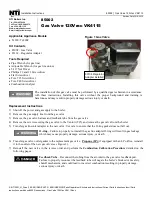
INSTALLATION AND OPERATION INSTRUCTIONS
1-6
SL 80-399 MODULATING GAS BOILER
SL 26-260 G3, SL 40-399 G3 MODULATING GAS BOILERS
•
Place in operation the appliance being inspected. Follow the lighting instructions.
Adjust the thermostat so that the appliance operates continuously.
•
After it has been determined that each appliance remaining connected to the common
venting system properly vents when tested as outlined above, return doors, windows,
exhaust fans, fireplace dampers and any other gas-burning appliance to their
previous condition.
•
Any improper operation of the common venting system should be corrected so the
installation conforms with the National Fuel Gas Code, ANSI Z223.1 - latest edition.
In Canada, all installations must conform with the current CAN/CGA - B149.1-10
Installation Code and/or local codes.
1.4.1 Applications
All SL series boilers are approved with alternative venting options: either 2-pipe Direct
Vent or Vent pipe with Indoor Air, offering flexibility to meet the specific requirements of
the installation. With the Direct Vent case, combustion air is piped directly to the boiler’s
air intake from outdoors
(see Section 1.4.7 for air intake piping requirements).
Using the
indoor air alternative, air for combustion is drawn from the indoor air surrounding the
boiler.
Provided the maximum overall vent length limit is not exceeded, the installer may choose
to vent the boiler through the wall, directly through the roof, or upward using an existing
- but otherwise unused - chimney as a vent raceway.
1.4.2 Exhaust Vent Material
Exhaust Vent Material – CANADA
Use PVC, CPVC or Polypropylene (PPs) vent component systems approved under
ULC-S636 Standard for Type BH Gas Venting Systems, or stainless steel Type BH venting
systems*. The vent temperature is limited with the use of a flue temperature sensor
and software to ensure the maximum temperature of the PVC venting material is not
exceeded. The temperatures are typically:
•
ULC-S636 PVC: 158°F (70°C)
•
ULC-S636 CPVC: 212°F (100°C)
•
ULC-S636 PPs:- 249°F (120°C)
Exhaust Vent Material – USA
PVC, CPVC or PPs venting materials are approved for use with these boilers in the USA.
The vent temperature is limited with the use of flue temperature sensor and software to
ensure that the maximum temperature of the PVC venting material is not exceeded. PVC
venting material shall be certified to Sch. 40 ASTM D1785 or D2665. CPVC material shall
be certified to Sch. 40/ASTM F441.
Do not use ABS or any cellular core pipe for exhaust venting.
Use of cellular core PVC (ASTM F891), cellular core CPVC, or Radel®
(polyphenolsulfone) in venting systems shall be prohibited.
The boiler offers 3" or 4" venting connections. Fittings are to be used to adapt to the
appropriate diameter – see Vent Travel below. Exhaust venting is to be inserted directly
into the 3" or 4" female stainless steel fitting (see Figure 3).
WARNING
Covering non-metallic vent
pipe and fittings with thermal
insulation shall be prohibited.
WARNING
Condensate can cause corrosion
of metal roofing components
and other roofing materials.
Check with the builder or
roofing contractor to ensure
that materials will be resistant to
acidic condensate. pH levels can
be as low as 3.0















































